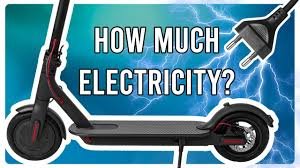How Much Electricity Does an Electric Scooter Use?
Electric scooters are becoming a popular eco-friendly transportation option. But how much electricity do they actually use? This article breaks down the energy consumption of electric scooters, giving you a clear understanding of their efficiency and cost.

Electric scooters are a fantastic alternative to traditional transportation, offering convenience and sustainability. With their rise in popularity, many wonder, “How much electricity does an electric scooter use?” Understanding this is crucial for both riders and potential buyers, especially when considering the impact on your electricity bill and the environment.
Understanding Electric Scooter Power Consumption
Electric scooters typically run on rechargeable lithium-ion batteries. These batteries convert electrical energy into mechanical energy to power the scooter's motor. The amount of electricity an electric scooter uses depends on various factors, including battery size, motor power, and how long the scooter is used.
Most electric scooters are powered by batteries ranging from 36V to 48V. The larger the voltage, the more powerful the scooter, which often means it will use more electricity. A typical electric scooter battery has a capacity of around 250 to 500 watt-hours (Wh). This is the amount of energy the battery can store.
How Much Power Does an Electric Scooter Use?
To get a better sense of how much electricity an electric scooter uses, it helps to know how many watt-hours (Wh) the scooter consumes per ride. A general rule of thumb is that most scooters use about 0.5 kWh (kilowatt-hour) for a 10 to 20-mile ride. To put this in perspective, 1 kWh is the amount of energy consumed by running a 100-watt light bulb for 10 hours.
So, if you ride your electric scooter for about 10 miles, you’ll likely use about 0.5 kWh. This amount is equivalent to running an energy-efficient appliance like a refrigerator for a few hours. Therefore, the electricity consumption is relatively low when compared to traditional vehicles that rely on gasoline or diesel.
Factors That Affect Electricity Usage
Several factors influence how much electricity your electric scooter uses. Here are the main ones:
- Motor Power: Higher-powered motors consume more electricity. A motor rated at 250W will generally consume less energy than a 500W motor. For faster speeds or steeper inclines, the scooter’s motor works harder, increasing energy usage.
- Terrain: Riding on flat terrain uses less electricity than climbing hills. If your commute involves a lot of uphill riding, your scooter will draw more power.
- Riding Speed: The faster you ride, the more energy the scooter will consume. Riding at top speed consumes more power than riding at a moderate pace. The more you push the scooter, the more electricity it uses.
- Battery Efficiency: Battery technology continues to improve, and modern lithium-ion batteries are quite efficient. However, the battery's age and condition can impact energy consumption. Older batteries may lose efficiency, requiring more electricity to achieve the same distance.
- Weight Load: Heavier riders or carrying additional cargo will cause the scooter’s motor to work harder, thereby consuming more electricity.
Cost of Charging an Electric Scooter
One of the main advantages of electric scooters is their cost-efficiency compared to cars. But how much does it actually cost to charge an electric scooter?
Charging an electric scooter typically costs between 5 and 10 cents per charge, depending on local electricity rates. If we consider an average of 0.5 kWh per ride, it would cost around 5 to 10 cents to charge your scooter fully. If you ride your scooter regularly, the cost can add up, but it’s still far cheaper than fueling a car.
For instance, charging an electric scooter every day for a month could cost between $1.50 and $3.00. Compared to the gas expenses of a typical car, this is incredibly cost-effective.
How Often Do You Need to Charge?
The frequency of charging depends on how often and how far you ride your electric scooter. Most electric scooters can last between 15 and 40 miles on a single charge, depending on the model and usage. If your daily commute is around 10 to 15 miles, charging the scooter once a day is usually enough.
If you use the scooter for longer trips, you might need to recharge it more frequently. Fortunately, electric scooter batteries can be charged relatively quickly, typically within 4 to 8 hours, depending on the battery size and charger.
Environmental Impact
Electric scooters have a significantly lower carbon footprint compared to gasoline-powered vehicles. Since they use electricity, they produce no emissions during operation. This makes them an eco-friendly alternative for short trips, helping to reduce pollution and reliance on fossil fuels.
However, the environmental impact also depends on how the electricity is generated in your region. If your electricity comes from renewable sources, such as wind or solar, your electric scooter's carbon footprint is even lower. On the other hand, if your electricity comes from coal or other non-renewable sources, the environmental benefits are slightly diminished.
Conclusion
In conclusion, the amount of electricity an electric scooter uses is relatively low compared to traditional vehicles. With the average cost per charge being just a few cents, electric scooters provide a cost-effective, eco-friendly solution for short-distance travel. The amount of electricity used will vary based on factors such as the motor power, terrain, and rider weight, but it remains a fraction of what you'd expect from gas-powered vehicles. For more details on optimizing your electric scooter's usage and battery efficiency, check out Tensela.
What's Your Reaction?



















